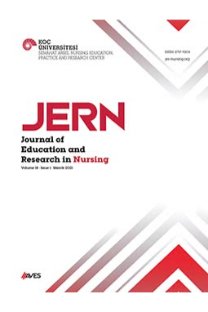Hemşirelik Modeli ve Bakım: Kısa Barsak Sendromu Tanılı Bir Bebeğin Levine Koruma Modeli İle Değerlendirilmesi
İnce bağırsakların anatomik/fonksiyonel kaybı sonucunda meydana gelen kısa barsak sendromu, tedaviye dirençli ishal, steatore, kilo kaybı, malnütrisyon, malabsorbsiyon ve dehidratasyonla kendini gösteren bir hastalıktır. Kısa barsak sendromunun yönetiminde hemşirelik süreci çok önemlidir ve bu süreç kuram ve modeller ile sentezlendiğinde hemşirelere rehberlik etmektedir. Hemşirelikte kullanılan modellerden biri olan Levine Koruma Modeli’ nin amacı; uyumu desteklemek için koruma ilkelerini kullanarak bireyin bütünlüğünü sağlamaktır. Hemşire enerjinin, yapının, bireysel ve sosyal bütünlüğün korunması yoluyla modeldeki hedefleri gerçekleştirmektedir. Bu makalede; Levine Koruma Modeli açıklanmış ve Kısa Barsak Sendromu olan dört aylık bir bebeğin bakımında model kullanımına yönelik bir örnek oluşturulmuştur.
Nursing Model and Care: Evaluation of a Diagnosed Infant with Short Bowel Syndrome by Levine Protection Model
Short bowel syndrome is a disease characterized by an anatomic/ functional loss of the small intestine, treatment-resistant diarrhea, steatorrhea, weight loss, malnutrition, malabsorption, and dehydration. The process of nursing care is very important in the management of short bowel syndrome and guides the nurses when synthesized with theories and models. One of the models used in nursing, Levine’s conservation model, aims to ensure the integrity of the individual using conservation principles to promote harmony. The nurse achieves the objectives of the model through the conservation of energy, structure, and individual and social integrity. In this article, the Levine conservation model is described as an example for guiding the care of a four-month-old infant with short bowel syndrome.
___
- 1. O’Keefe SJD, Buchman AL, Fishbein TM, Jeejeebhoy KN, Jeppesen PB, Shaffer J. Short bowel syndrome and intestinal failure: Consensus definitions and overview. Clinical Gastroenterology and Hepatology. 2016;4(1),6-10. doi: 10.1016/j.cgh.2005.10.002.
- 2. Terri LB. Wong’s essentials of pediatric nursing. 9th ed. Hockenberry M, Wilson D, editors. Elsevier Inc; 2009. p. 635-46.
- 3. Tappenden KA. Pathophysiology of short bowel syndrome: Considerations of resected and residual anatomy. JPEN J Parenter Enteral Nutr. 2014;38(1 Suppl):14S-22S. doi: 10.1177/0148607113520005.
- 4. Vanderhoof JA, Young RJ. Enteral and parenteral nutrition in the care of patients with short-bowel syndrome. Best Practice & Research Clinical Gastroenterology. 2003;17(6):997-1015. doi: 10.1016/S1521- 6918(03)00082-9.
- 5. Squires RH, Duggan C, Teitelbaum DH, et al. Natural history of pediatric intestinal failure: Initial report from the Pediatric Intestinal Failure Consortium. The Journal of Pediatrics. 2012;161(4):723-8. doi: 10.1016/j.jpeds.2012.03.062.
- 6. Mayr JM, Schober PH, Weibensteiner U, et al. Morbidity and mortality of the short-bowel syndrome. Eur J Pediatr Surg. 1999;9:231-5. doi: 10.1055/s-2008-1072251.
- 7. Wasa M, Takagi Y, Sando K, et al. Intestinal adaptation in paediatric patients with short-bowel syndrome. Eur J Pediatr Surg. 1999;9:207-9 doi:0.1055/s-2008-1072245.
- 8. Seetharam P, Rodrigues G. Short bowel syndrome: A review of management options. Saudi Journal of Gastroenterology. 2011;17(4):229. doi: 10.4103/1319-3767.82573.
- 9. Lentze MJ. Nutritional aspects of short bowel syndrome. Pediatr Surg Int. 1988;3(5):312-7. Available from: https://link.springer.com/ article/10.1007/BF00189168
- 10. Alligood MR. Nursing theorists and their work-e-book. Elsevier Health Sciences; 2017.
- 11. Levine ME. The four conservation principles of nursing. Nursing Forum. 1967;6(1):45-59. doi: 10.1111/j.1744-6198.1967.tb01297.x.
- 12. Levine ME. The conservation principles; A retrospective. Nursing S c i e n c e Q u a r t e r l y . 1 9 9 6 ; 9 ( 1 ) : 3 8 - 4 1 . d o i : 10.1177/089431849600900110.
- 13. Mock V, StOurs C, Hall S, et al. Using a conceptual model in nursing research–mitigating fatigue in cancer patients. Journal of Advanced Nursing. 2007;58(5):503-12. doi: 10.1111/j.1365-2648.2007.04293.x.
- 14. Carpenito-Moyet LJ. Hemşirelik tanıları el kitabı. Erdemir F, translator. İstanbul: Nobel Tıp Kitapevleri; 2012.
- 15. Velioğlu P. Hemşirelikte kavram ve kuramlar. İstanbul: Alaş Ofset; 1999.
- 16. Karagözoğlu Ş. Myra Estrin Levine. In: Karadağ A, Çalışkan N, Baykara Göçmen Z, editors. Koruma modeli: Hemşirelik teorileri ve modelleri. İstanbul: Akademi Basın ve Yayıncılık; 2016.
- ISSN: 2618-5741
- Yayın Aralığı: Yılda 4 Sayı
- Başlangıç: 2004
- Yayıncı: Koç Üniversitesi HYO Semahat Arsel Hemşirelik Eğitim ve Araştırma Merkezi (SANERC)
Sayıdaki Diğer Makaleler
Hemşirelik Öğrencilerinin Reçetesiz İlaç Kullanma Durumları
Semra AÇIKSÖZ, Gönül KURT, Merve SEYFİ
Merve GÜMÜŞ, Yasemin YILDIRIM, Fisun ŞENUZUN AYKAR
Emine Emel KAYIKÇI, GÜLBEYAZ CAN
Uçuş Hemşireliği: Norveç ve Avustralya Örneği
Neuman Sistemler Modeline Göre Peritoneal Karsinomatozisli Hastanın Bakımı: Olgu Sunumu
Emine ARICI PARLAK, Gülten GÜVENÇ, Emine İYİGÜN
Doğu Ontario Çocuk Hastanesi Ağrı Ölçeği: Geçerlik ve Güvenirlik Çalışması
Aylin KURT, Müge SEVAL, Ceyda AFACAN
Hemşirelerin İntramüsküler Enjeksiyon Uygulamasında Ventrogluteal Bölgeyi Kullanmama Nedenleri
Yeter Sinem ÜZAR ÖZÇETİN, DUYGU HİÇDURMAZ
Gebe Kadınlarda Gebelik Algısının Stres, Demografik ve Obstetrik Özellikler Açısından İncelenmesi
